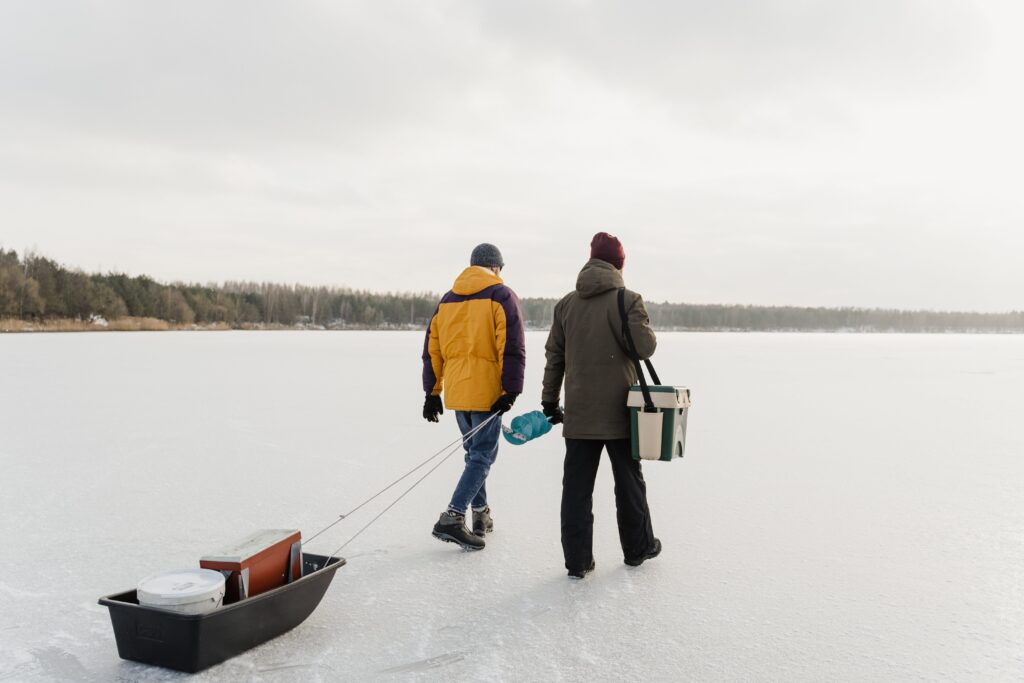Hey there anglers! Its almost that time of the year again. Lakes are freezing up and ice fishing is right around the corner. If you are new to ice fishing, selecting the right gear can be daunting. However, having the appropriate equipment is critical in determining your success and safety out on the ice. For that reason, we’ve compiled a list of everything you’ll need to get started ice fishing. So, let’s gear up and dive into everything you need to get started on your ice fishing journey.
The Angler’s Line is a participant in the Amazon Services LLC Associates Program as well as other affiliate programs designed to provide a means for sites to earn advertising fees by linking to Amazon and affiliated sites at no extra cost to you.
Best Ice Fishing Gear
Necessities:
Optional:
Ice Augers
In order to drill a hole in the ice, you’re going to need an ice auger. The two main types of augers on the market are hand powered augers or electric powered augers. Gas augers used to be popular, but have decreased in popularity since electric augers came along. There are fully electric augers or augers that can be used with a cordless drill. It is important to make sure that you have a drill capable of handling an ice auger before going this route. Electric augers are much more efficient and can drill holes much quicker in general. However, hand augers will suffice when ice is less than a foot in depth.
As far as size goes, this depends on the fish you are targeting. For panfish, any auger between 5″ to 8″ will work just fine. If you primarily are targeting game fish, upsizing your auger to between 8″ to 10″ may be beneficial. 8″ is a great all around size for someone just getting started.
Some Good Options:
Ice Fishing Rods
When talking about the best ice fishing gear, it is impossible to not mention ice fishing rods. Compared to traditional rods, ice fishing rods are much shorter and softer. However, ice fishing rods can still vary a lot depending on the type of application you are using them for.
Panfish:
For panfish, having a soft rod tip is critical. This will allow you to detect even the most subtle of bites. A soft tip can be achieved in two ways; a noodle tip rod or a spring bobber. This ultimately comes down to personal preference. Whichever route you choose to go, it’s important that the weight of your lure loads the rod tip slightly. This will allow you to detect up-bites as well, which crappies are notorious for.
Gamefish:
For gamefish, a slightly stiffer rod is better for both working your lure and fighting the fish. A medium-light to medium-heavy power ice fishing rod is ideal depending on the size of fish you are targeting and the weight of your lure.

Length:
The main consideration you’ll want to make when selecting an ice fishing rod length is whether you will be fishing in a shelter or outside. If you plan on fishing in a shelter, you’ll most likely benefit from having a rod under 30″ to give yourself enough room. If you plan on fishing outside a majority of the time, a slightly longer between 30″ to 36″ is my recommendation. A longer rod loads better than a shorter rod and keeps hooks pinned better as a result.
Some Good Options:
13 Fishing Omen Ice Rod (Gamefish)
St. Croix Rods Custom Ice Fishing Rod (Panfish)
Ice Fishing Reels
The two main ice fishing reels on the market are spinning reels and in-line reels. Each have their advantages and disadvantages. Spinning reels are a good budget option and generally have reliable drag systems. In-line reels have come a long way in recent years however. The main advantage to in-line reels is that they minimize line twist, preventing your lure from spinning underneath the ice. This is especially important when fishing light jigs for finicky panfish, but less critical when using heavy spoons for larger fish. Choose whichever model that you prefer. As far as size goes, 500 is a good size for panfish and 1000-1500 is ideal for ice fishing for gamefish.
Some Good Options:
13 Fishing Freefall Ghost (In-Line)
13 Fishing Wicked (Spinning Reel)
Ice Fishing Line
Unfortunately, there is no one size fits all option when it comes to ice fishing line. Some anglers will tell you one thing while another angler may tell you the complete opposite. The truth is that all of the types of line (braid, monofilament, and fluorocarbon) work for ice fishing. Just make sure that they are ice specific lines since they will handle much better in the cold conditions.
Braid typically works best when fishing primarily in a shelter or when it is above freezing outside. If you primarily fish outside, braid tends to collect water and freeze. The advantage of using braided line is its superior sensitivity. Make sure to use a fluorocarbon or monofilament leader to prevent fish from seeing the line when fishing in clear water.
Monofilament is a great all around option for ice fishing. It performs very well in cold conditions and has stretch which help keep fish pinned. This is especially useful in shallow water.
Fluorocarbon is a great option when fishing in ultra-clear water due to its low-visibility. This is one situation where you don’t want to buy the cheap stuff. A high quality ice fishing fluorocarbon will have less memory and fish much better than a low-quality one. Trust me.
Tailer the size of your ice fishing line to the fish you will be targeting. For panfish, 2-6lb test will work just fine. For gamefish, 6-10 lb test is a good starting point most of the time.
Some Good Options:
Ice Fishing Lures
Ice fishing lures are one key component to your ice fishing gear. The truth is, you can make it as complicated as you want. I’ll do my best to simplify this category by providing touching on two of the main lures used; spoons and jigs.
Spoons can be used for either panfish or gamefish depending on the size of spoons you choose. For panfish, a 1/32 – 1/8 oz spoon is generally the way to go. For gamefish, upsize to a 1/8 – 3/8 oz spoon depending on the depth you are fishing in and the size of fish you will be targeting. Feel free to tip the spoon with live bait to add scent when the fish are finicky.
Jigs have been popular amongst ice fisherman for a very long time. You can either tip them with live bait or soft plastics and fish them at a variety of depths. This makes them arguably one of the most versatile lures for ice fishing. The two main types of ice fishing jigs are tungsten and lead. Tungsten is denser than lead which allows the same size jig to be heavier. Opt for tungsten when you need to downsize your presentation in deep water.
Some Good Options:
Bibs and Jackets
I know it’s hard to believe, but ice fishing is actually pretty cold. In all seriousness, having a dedicated ice fishing suit can make a world of difference in how comfortable you stay on the water. A good ice fishing suit will be waterproof and provide the insulation that you need to stay warm on the ice. Additionally, some suits have built in flotation which provides an additional safety measure in case you were to break through.
Some Good Options:
Safety Equipment
We can’t talk about the best ice fishing gear without mentioning safety. Ice safety is imperative, so be sure to have the right safety equipment in case something were to happen. Two critical pieces of safety equipment for ice fishing include a spud bar and picks. A spud bar is useful because it helps you check the ice thickness before walking out. Be sure to check the general ice thickness guidelines to know whether or not the ice you are on is thick enough. Ice picks are another important piece of safety equipment that allows you to climb out of the ice if you were to fall in. Without them, it is very difficult to form enough friction to pull yourself out.
Another piece of safety equipment that may be surprising to some is the ice fishing suit that you wear. Ice fishing float suits have been growing in popularity, and help keep you afloat in the case that you break through the ice.
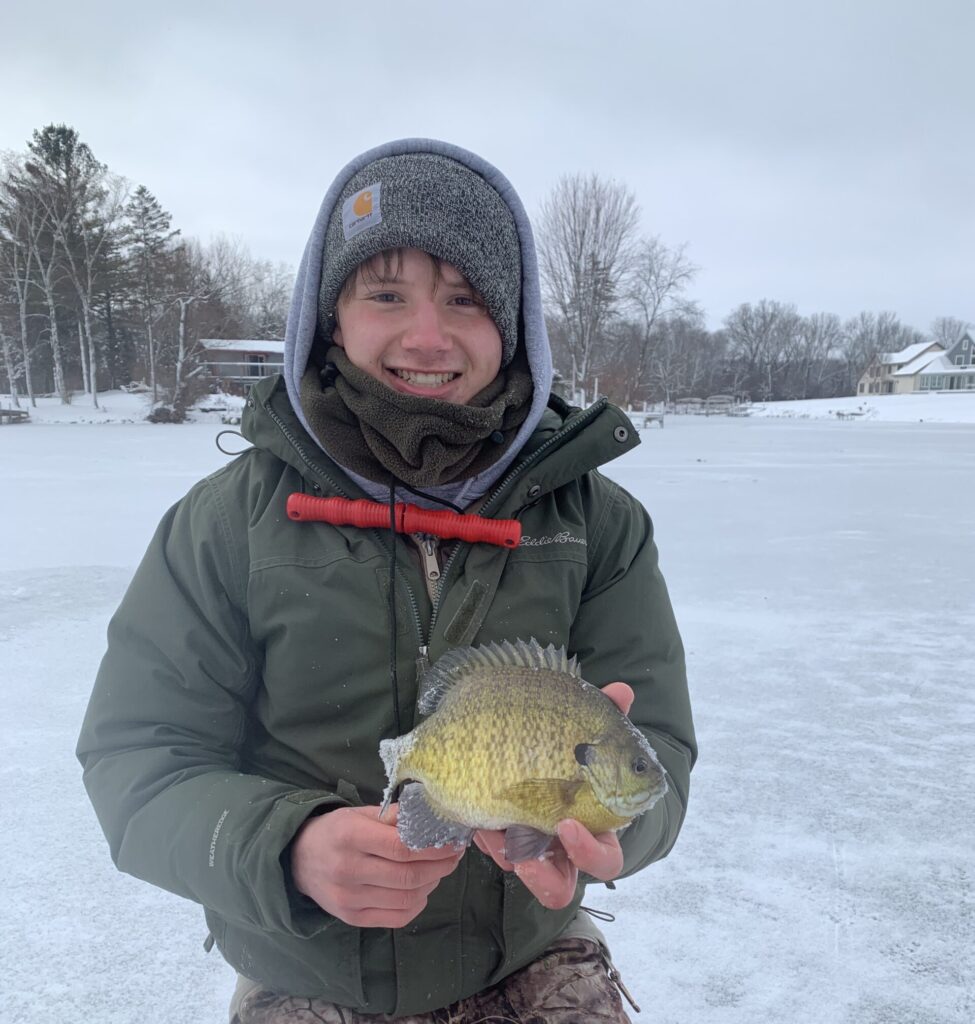
Some Good Options:
Electronics
Here’s the fun part. Although not necessary, electronics make a massive difference when ice fishing. Unlike open water fishing, it is very difficult to cover water when fishing stationary over the top of a hole in the ice. For this reason, it is imperative to make sure that you are over the top of fish at all times. If not, you should hole hop until you mark fish with your electronics.
The two main types of electronics used in ice fishing are flashers and forward facing sonars. Forward facing sonars can scan the water column over 100 ft out. This allows you to locate schools of fish quickly when fishing expansive areas. Meanwhile, flashers are generally better once you have already found the fish and are ready to fish for them. Fishing electronics are definitely not the cheapest piece of ice fish. However, if you plan on taking ice fishing seriously it is worth
Some Good Options:
Garmin Panoptix LiveScope Ice Fishing Bundle (Forward Facing Sonar)
Vexilar Fl-18 (Flasher)
Shelter
When it’s cold and windy, an ice fishing shelter is a great piece of gear to have. The two main types of ice fishing shelters are hubs and flip-over shelters. Hubs are generally larger and have to be transported onto the ice in a separate sled. Hubs range from about 2 to 6 people, so choose the size accordingly. Meanwhile, flip-over shelters are built into the sled. This allows you to put everything in one place which makes it a bit more convenient. One thing to keep in mind is that flip-over shelters can generally only accommodate one to two people.
Some Good Options:
Clam Yukon XT Thermal Blue (Flip-over Shelter)
More Information
There you have it! All of the best ice fishing gear that you will need to get started. I know that was a lot, but I hope you found it helpful to have everything condensed into one place. For those who haven’t tried it, ice fishing provides some incredible fishing opportunities for many species. As always, make safety your priority. Tight lines!
More Ice Fishing Articles:
- The Best Ice Fishing Float Suits
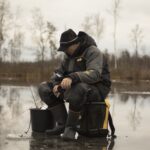
- The Best Ice Augers For Cordless Drills
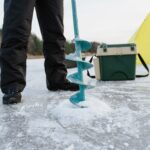
- The Best Drills For Ice Augers
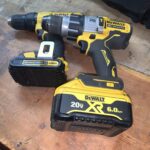
- The Best Flasher For Ice Fishing [Complete Buyer’s Guide]
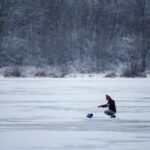
- Best Vexilar For The Money [Complete Guide]
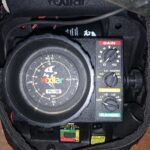
- Best Ice Fishing Gear: Everything You Need To Get Started
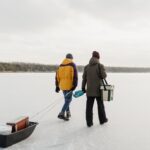
- Ice Fishing For Walleye: Everything You Need To Know

- Ice Fishing For Crappie: Everything You Need To Know

More Gear Reviews:
- The Best Ice Fishing Float Suits

- The Best Ice Augers For Cordless Drills

- Best Ice Fishing Gear: Everything You Need To Get Started

- Revelead: The Best 3 Baits For Bass Fishing at Night!

- Ultimate Canoe Fishing Arsenal: Top 7 Best Canoe Fishing Accessories

- Net Success: Top 3 Best Fishing Nets For Walleyes
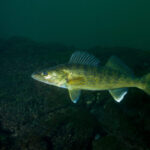
- Shoreline Secrets: Best Gear For Shore Fishing To Make Your Life Easier

